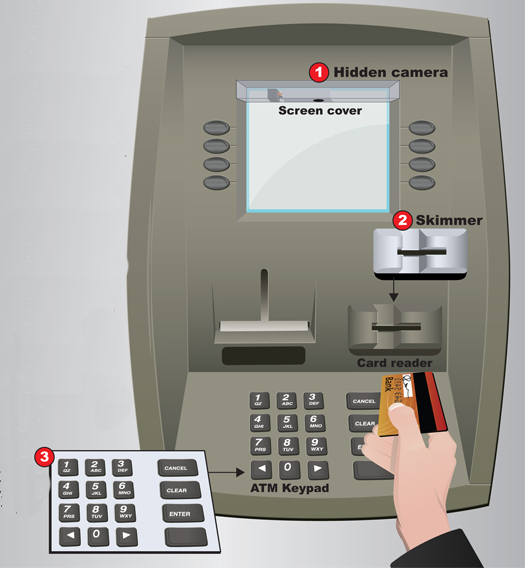posted
on Tuesday, May 30, 2017
in
Security & Fraud Information
“ATM skimming" Is when a criminal places an electronic device on an ATM that scoops information from a bank card’s magnetic strip whenever a customer uses the machine.
How skimming works
The devices planted on ATMs are usually undetectable by users—the makers of this equipment have become very adept at creating them, often from plastic or plaster, so that they blend right into the ATM’s façade. The specific device used is often a realistic-looking card reader placed over the factory-installed card reader. Customers insert their ATM card into the phony reader, and their account info is swiped and stored on a small attached laptop or cell phone or sent wirelessly to the criminals waiting nearby.
Skimming devices are installed for short periods of time—usually just a few hours—so they’re often attached to an ATM by nothing more than double-sided tape. They are then removed by the criminals, who download the stolen account information and encode it onto blank cards. The cards are used to make withdrawals from victims’ accounts at other ATMs.
How to avoid being skimmed
- Inspect the ATM, gas pump, or credit card reader before using it…be suspicious if you see anything loose, crooked, or damaged, or if you notice scratches or adhesive/tape residue.
- When entering your PIN, block the keypad with your other hand to prevent possible hidden cameras from recording your number.
- If possible, use an ATM at an inside location (less access for criminals to install skimmers).
- Be careful of ATMs in tourist areas…they are a popular target of skimmers.
- If your card isn’t returned after the transaction or after hitting “cancel,” immediately contact the financial institution that issued the card.
ATM Skimming
Skimming is an illegal activity that involves the installation of a device, usually undetectable by ATM users, that secretly records bank account data when the user inserts an ATM card into the machine. Criminals can then encode the stolen data onto a blank card and use it to loot the customer’s bank account.
- Hidden camera
 A concealed camera is typically used in conjunction with the skimming device in order to record customers typing their PIN into the ATM keypad. Cameras are usually concealed somewhere on the front of the ATM – in this example, just above the screen in a phony ATM part – or somewhere nearby (like a light fixture).
A concealed camera is typically used in conjunction with the skimming device in order to record customers typing their PIN into the ATM keypad. Cameras are usually concealed somewhere on the front of the ATM – in this example, just above the screen in a phony ATM part – or somewhere nearby (like a light fixture).
- Skimmer The skimmer, which looks very similar to the original card reader in color and texture, fits right over the card reader – the original card reader is usually concave in shape (curving inward), while the skimmer is more convex (curving outward). As customers insert their ATM card, bank account information on the card is “skimmed,” or stolen, and usually stored on some type of electronic device.
- Keypad Overlay
The use of a keypad overlay - placed directly on top of the factory-installed keypad – is a fairly new technique that takes the place of a concealed camera. Instead of visually recording users punching in their PINS, circuitry inside the phony keypad stores the actual keystrokes.